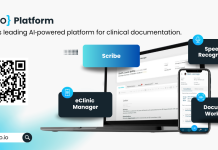Nicola Hall, the Director NAO Consultancy Ltd discusses the point of care under the advancement of technology and digital transformation
The use of technology at the point of care in healthcare has developed over the last fifteen years and we are seeing an acceleration as the benefits of information and data collection have become much clearer.
When I first approached the market looking to improve inventory management and recording product usage to the patient, the practice was very limited.
There had been a few attempts by enlightened individuals to try something similar, but the success rested on the individual maintaining the initiatives. There was no central programme. Inevitably, if that individual moved on the program would lose momentum unless there was someone to take up the baton.
At that stage, information regarding implants was stored as paperwork in hospitals but proved to be information that could not be mined when needed, as it was not digitised.
Events with medical devices started to trigger a change in mindset
There were a couple of significant medical product issues a hip joint causing issues in patients and then later the PIP breast implant issues Review into PiP implant scandal published – GOV.UK (www.gov.uk). The patients affected simply could not be adequately traced, and there was a delay in understanding there was an issue with the products, consequently, more patients were affected in the longer term than should have been.
These product events coincided with a call for procurement evidence Procurement call for evidence – GOV.UK (www.gov.uk), and a report from McKinsey which resulted in a number of paid-for trials for the scan4safety project Home – Scan4Safety – Scan4Safety | Scan4Safety and in the end six trusts were awarded funds to explore the benefits of using technology at the Point of Care, as lighthouse projects for the rest of the NHS.
Today we see a firm initiative for Scan4safety across the UK, managed and promoted by the GS1 UK team. This initiative is very much around the use of barcoding and using scanning to capture the products available and used on the patient in the healthcare environment. To date, the focus has been mainly on the Acute sector in the UK.
The COVID pandemic had major impacts across the board on the NHS
The benefits of the use of technology soon became very evident, and in some areas, adoption has been almost immediate. However, the pandemic also highlighted what was missing and despite the Scan4safety programme being underway in some Acute Trusts, it became quickly evident that the government did not know what each hospital had in supplies of PPE and where they needed to ensure supplies were sent to. The immediate answer to this was a manual PPE tracker where each Trust had to manually enter the number of supplies that they had on the shelf so the government could see the picture centrally. On the ground for those Trusts not using Inventory management solutions this meant staff available to count and enter the stock manually every day. The inefficiency of that process and the manpower involved became quickly evident.
In 2021 Baroness Cumberledge’s report Independent Medicines and Medical Devices Safety Review report – GOV.UK (www.gov.uk) focused on three products that had also caused harm to patients. The outcome of that is that tracking products used on patients and having a centralised database so that issues can be identified sooner is a key to enhancing patient safety. The change here for healthcare was that this should be thorough the whole patient journey primary and secondary care. This increases the need for technology at the point of care into the much wider area of primary care.
The primary focus is patient care
The benefits of point of care scanning are now understood, with the primary focus being patient care. However, the other spin-off benefits are huge to the implementing organisations, too. The Acute sector has a huge spend on medical products, devices, and pharmaceuticals. The better management of inventory has significantly reduced wastage, improved availability, reduced the cost of over-stocking and under-stocking, and released clinical time back to patients, not product ordering.
Whilst the UK healthcare system is still trying to recover from the effects of the pandemic, Brexit and the economic pressures that we all are facing, resources to implement further technology changes in the environment are limited so we have once again seen a slowing down of adoption. However, it won’t be for long.
The wider adoption of Point of Care data collation be it through bar code scanning, RFID or Blue tooth low energy has the potential to revolutionise the way that products are replenished in the NHS, and data collated about the patient throughout the patient’s use of various services.
The current costly method of reordering products could be replaced by a full push supply chain model which is in line with the government’s drive to centralise procurement activities. Large data companies marry up predictive data, outcome data and visibility at the point of care to determine requirements and who knows whether in the future we will see specialised deliveries for planned procedures, maybe even via drones.
Opening the use of technology at the point of care for back-office functions has the potential to drive some of the largest changes we have seen in healthcare, but it very much relies on wider adoption, and the drive behind this to date has been very slow. Those who have taken up the programme have realised benefits, improved patient care and, more importantly, see the other applications that the technology could help to improve. Healthcare is a complicated environment, but good technology adoption is key to solving some of the issues it faces.
The paradigm thinking that accepts technological advances in the treatment of a patient needs to be adopted in the modernisation of the back office. The data that these changes bring offer us further opportunities for modernisation and efficiencies that are sorely required to preserve our NHS and make it affordable for the following generations.

This work is licensed under Creative Commons Attribution-NonCommercial-NoDerivatives 4.0 International.











